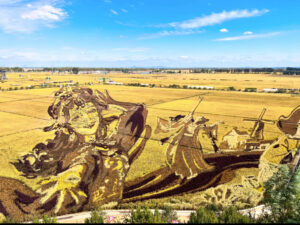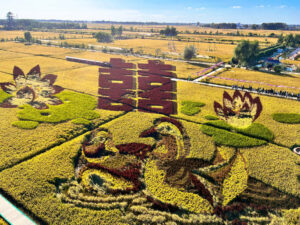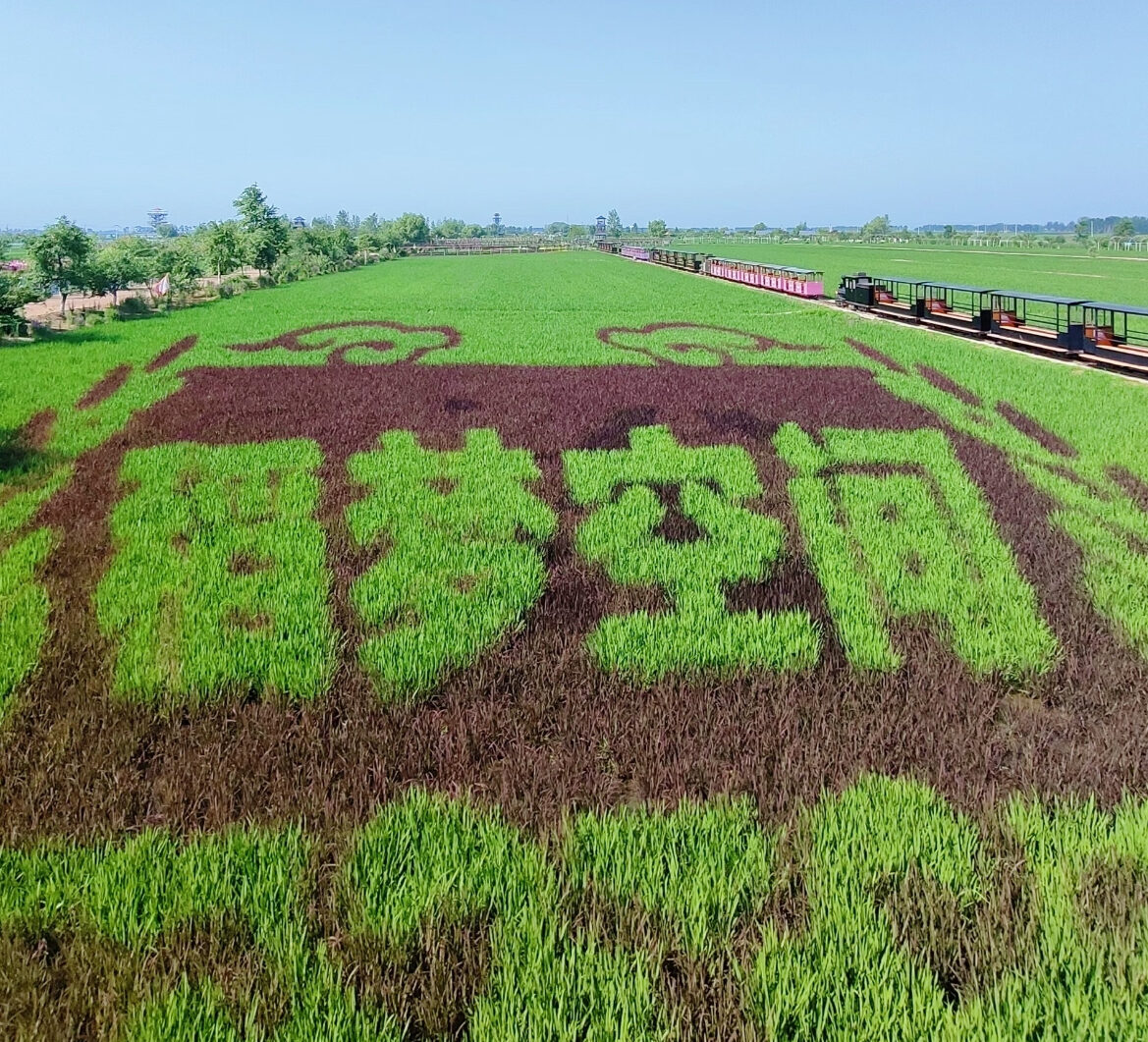Background and Features
1. Artistic Innovation in Rice Paddy Art
“Rice Dream Space” in Shenbei New District, Shenyang, is the largest rice paddy art-themed agricultural park in northern China. By planting different varieties of rice with varying colors and integrating GPS positioning and 3D perspective technology, large-scale three-dimensional artworks are “painted” onto vast rice fields. These artworks feature themes such as Journey to the West and Rural Revitalization, with new designs created annually, attracting a large number of visitors.
2. Local Integration of Peasant Paintings
The park combines Northeast Chinese folk culture with rice paddy art, incorporating elements such as Manchu cultural symbols and harvest scenes. Additionally, the park showcases peasant-created paintings, straw weaving, and other handicrafts, forming a distinctive cultural identity where “the farmland is the canvas, and the farmers are the artists.”



Rice field painting
Analysis of Success Factors
1. Technology-Driven Agriculture: Breaking Traditional Models
•Technological Support: Utilizing satellite positioning, drone mapping, and other technologies ensures precision in designing rice paddy art, enhancing both visual effects and farming efficiency.
•Extended Industrial Chain: The popularity of rice paddy art has led to the development of the Rice Dream rice brand, where consumers can scan QR codes to trace the specific planting area within the artwork. This approach integrates agriculture, tourism, and cultural creativity (agri-tourism and cultural industries).
2. Government Guidance and Market-Oriented Operations
•Policy Support: The government facilitates land transfer policies and brings in professional cultural tourism companies to operate the park.
•Farmer Participation: Farmers become shareholders by contributing their land, earning dividends while also participating in planting, maintenance, and tourism services, transforming resources into assets and farmers into stakeholders.
•Economic Impact: In 2021, the park received over 500,000 visitors, increasing the average annual income of local farmers by more than ¥20,000.
3. Cultural IP and Brand Marketing
•Film Industry Exposure: The park gained nationwide attention as a filming location for the movie My People, My Hometown (specifically the The God Pen Ma Liang segment starring Shen Teng and Ma Li), turning it into a viral tourist destination.
•Thematic Events: Events such as the Rice Field Music Festival and Farmers’ Harvest Festival maintain continuous public engagement and media coverage.
4. Community Involvement and Shared Benefits
•Farmers as Creators and Beneficiaries: Local villagers actively participate in rice paddy art planting, work as tour guides, and run farm stays, enabling employment opportunities close to home.
•Cooperative Model: A farmers’ cooperative was established to centrally manage agricultural product sales and tourism services, preventing unhealthy competition.
Conclusion
The success of “Rice Dream Space” in Shenyang demonstrates that rural revitalization requires moving beyond single-industry development. By integrating cultural heritage, technological innovation, and shared benefits, it creates a new model of agriculture, culture, and tourism integration. The combination of peasant paintings and rice paddy art not only reshapes rural aesthetics but also empowers farmers as key participants and beneficiaries of revitalization, providing a replicable model for similar rural development projects.



6 February 2025 at 11:30
You have been posting frequently and it is good to see you developing a consistent practice of using your blog – keep this up!
In your Week 1 blog post, you write about the exhibition Waiting for Rain shared by one of your peers in our planning meeting. You describe this work and the way that the work is revealed when it rains. You refer to this as an innovative curatorial approach. I’d suggest that this is part of the work itself so is an artistic rather than curatorial approach.
Your post on the Chichu Art Museum evidences independent research and you engage well with the museum’s display of Monet’s work and the associated garden development, considering how this resonant space might impact the audience’s understanding and appreciation of the art.
Your post on Rice Dream Space is also interesting and relevant to the project you are considering developing for your proposal. In this post, it would be useful to include some reflection on what you can learn from this project for your own work.
Your Week 2 post shows that you already have a focus for your curatorial project proposal and it is good to see you thinking about the wider impact of such a project – connecting to rural tourism. You cover a number of different elements – from collaborations with designers for brand development, academic cooperation, interactive displays. I’d encourage you to refine your approach so that you focus on a smaller number of elements and consider how these help to realise the aims of the exhibition.
You may find the work of MyVillages interesting – they are a collective that develop projects focused on the rural as a site of cultural production (https://myvillages.org/). Jatawangi Art Factory may also be of interest – they seek to create a collective awareness and identity for their region through arts and cultural activity (https://documenta-fifteen.de/en/lumbung-members-artists/jatiwangi-art-factory/)
You also suggest making use of exhibition spaces such as bookstores and fields. Deveron Projects’ Town Collection is a dispersed collection of artworks left by artists who have been on residency in the town and hosted in locations across the town – in shops, streets, homes, pubs. https://www.deveron-projects.com/town-collection/
I’d also encourage you to engage with some of the theory and writing around the rural as a context for artistic practice and projects. The book The Rural could be a useful place to start with extracts from lots of key texts on the subject in art including curatorial perspectives.
The Rural. London: Whitechapel Gallery, 2019 (https://discovered.ed.ac.uk/permalink/44UOE_INST/7g3mt6/alma9924152952702466)
Remember that the Blog toolkit encourages the inclusion of images. Your posts are all text only and images would be useful to give your reader a better sense of some of the things you discuss – eg. the gardens at the Chichu Art Museum or examples of the types of art you are thinking of including within your individual project proposal.